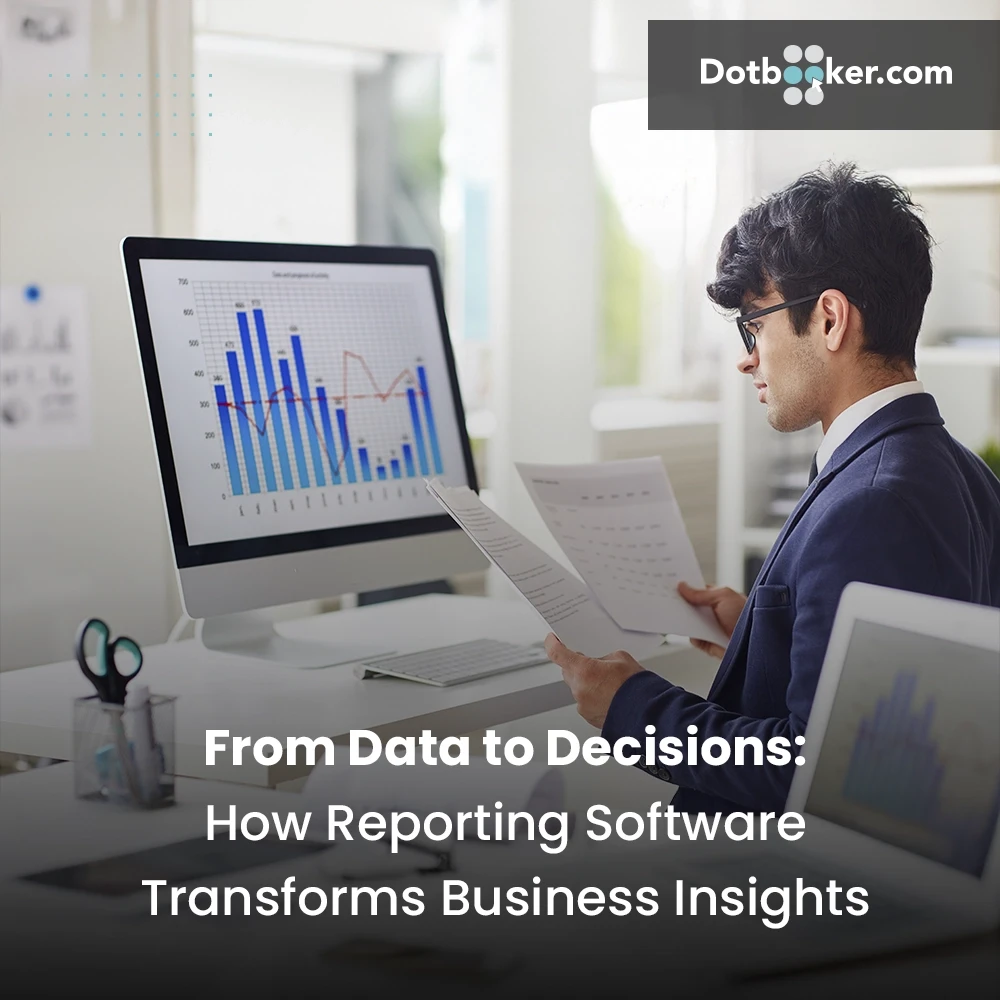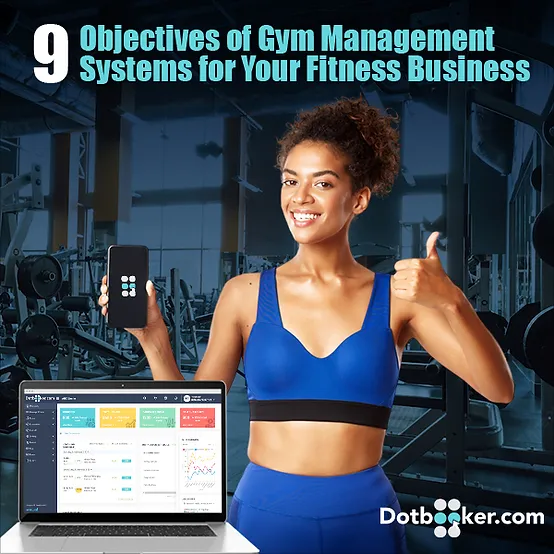
- By Dotbooker
- Jun 11, 2025
- 403
From Data to Decisions: How Reporting Software Transforms Business Insights
Nowadays, data is more than just a "nice-to-have "; it is the foundation of all business decisions. The worst part, though, is that data is just data. Having a treasure chest without a key is similar to that.
That’s where reporting software enters the scene—not as a dusty ledger replacement but as a dynamic, living system that transforms raw data into insights that can propel a business forward.
Let’s dive into the exciting journey from data overload to razor-sharp decision-making.
When Data Overflows, Reporting Software Throws You a Lifeline
Picture this: You’re running a business. Every department—sales, marketing, finance, HR—is generating data faster than you can say “spreadsheet.” Revenue reports, expense logs, sales figures, campaign metrics—they pile up like a digital mountain. You try to keep up with Excel sheets, but it’s like bailing water from a sinking ship with a teacup.
Due to its automation, integration, and real-time processing capabilities, reporting software can be particularly helpful in this situation. Rather than pursuing updates and wrestling with formulas, you get interactive dashboards that consolidate data from every corner of your business.
It's similar to moving from a flip phone to a modern smartphone, because everything you need is easily accessible and updated in real-time. All of a sudden, you stop battling with numbers and start planning clearly.
Financial Reporting: No More Guesswork, Just Actionable Insights
Let’s face it: traditional financial reporting often feels like peering through a foggy window.
- But what do the numbers mean?
- What connection do they have?
- Above all, what can you do to address them?
In this case, financial reporting software completely alters the rules.
See your financial information come to life. You see dynamic dashboards that monitor cash flow, profit margins, and revenue trends in real time rather than static rows and columns.
Rather than just a number, you see its story:
- Why did sales decline in Q2?
- Which product categories consistently outperform the competition?
- What effect does your seasonal revenue variation have on overall growth?
Let's add some interaction:
Scenario: You’re a CFO gearing up for the quarterly review. Instead of spending days compiling reports from different departments, you open your financial reporting software.
Instantly, you see a visual summary: expenses neatly categorized, revenues plotted against targets, and a predictive trendline showing potential growth in the next quarter.
Now, imagine asking your team, “What if we cut underperforming services by 10%?” The software generates a forecast in seconds, displaying potential savings and the impact on growth.
This is the power of modern financial reporting: it gives you insights you can act on instantly and confidently.

Expense Management: Taming the Chaos with a Digital Ally
Expenses. They’re like sneaky gremlins in your business—if you’re not watching, they’ll quietly drain your resources. Hand-tracking them is like playing whack-a-mole. Expense management software is your industrious, law-abiding, data-loving sidekick in this situation.
Let’s play out a day in your business:
- Morning: An employee submits an expense for a client lunch. Instead of emailing receipts or filling out forms, they snap a photo and upload it to the app. The software instantly reads the receipt, categorizes the expense, and checks it against company policies.
- Afternoon: A manager logs in to review approvals. They see a flagged expense—an unusually high hotel cost. One click shows it’s outside policy limits, and the system suggests a corrective action.
- Evening: Your finance team downloads a detailed report showing spending trends across departments, highlighting areas where policies are frequently breached or cost savings are possible.
Here’s the magic: expense management software doesn’t just reduce manual work—it helps you control spending, spot waste, and even renegotiate vendor contracts. It’s like having a financial guardian whispering in your ear, “Here’s where you can save more and spend smarter.”
Real-Time Reporting: Because Yesterday’s Data Can’t Shape Tomorrow
Imagine that you are navigating a ship through rough seas. Would you trust the weather report from yesterday? Not. The same is true for your company. Making decisions based on outdated information is akin to navigating in the dark. Real-time reporting changes the game at this point.
Your dashboards are more than just updated when you use contemporary reporting software; they are dynamic. As soon as a transaction is completed, sales data is updated. Every time a claim is accepted, costs are immediately adjusted. As new information becomes available, predictive models are updated.
Let’s make it vivid:
For instance, you own a wellness center. A sudden surge in online reservations on a busy Friday raises your revenue estimates.
The updated numbers are reflected in your real-time dashboard, which displays a spike in revenue and bookings. Your staff schedule, meanwhile, automatically adapts to the higher demand.
Or you are in charge of a chain of stores. Real-time reporting indicates that a local event has led to a decline in sales at one location. Instantly, you deploy a targeted promotion, and by afternoon, sales start to recover.
Not only is real-time reporting practical, but it also makes the difference between responding slowly and taking charge early. Which would you prefer: addressing an issue as it arises or learning about it days later?
The Strategic Edge: Turning Data into Decisions
Now, let’s talk about the big picture. Reporting software doesn’t just give you numbers; it empowers you to see beyond them. It transforms your role from data custodian to strategic visionary.
Here’s how it feels:
Interactive Thought: Imagine being in a strategy meeting. Someone says, “Let’s expand into a new market.” Instead of guessing, you pull up your financial reporting software and display a heatmap of past performance by region.
It shows which areas are booming and which are lagging. You overlay expense trends, identify cost-efficient markets, and in minutes, you’re outlining a data-backed plan.
Or perhaps your CEO asks, “Where can we cut costs without impacting growth?” You tap into your expense management software to pinpoint redundant vendor contracts or travel costs that could be trimmed.
This is strategic intelligence at its best. Leading is now more important than reacting. You can make bold, well-informed decisions that promote resilience, efficiency, and growth with the clarity and assurance that reporting software provides.
Unveiling the Hidden Heroes: The Automation Factor
Behind every jaw-dropping report and dashboard lies a quiet revolution—automation. Reporting software doesn’t just pull data; it connects, consolidates, and crunches it while you sleep. Automated data syncing from CRM, POS, ERP, and accounting platforms means no more chasing numbers across scattered systems.
Picture this:
Your sales system automatically feeds daily revenue data into the financial reporting software. In the meantime, HR platforms update payroll and benefits costs by syncing with expense reports.
Without you having to do anything, your dashboard is ready for you when you wake up, providing a fresh set of insights.
In addition to saving time, this seamless integration eliminates human error and establishes a data ecosystem where numbers communicate, collaborate, and inform strategy.
Customization: Your Data, Your Way
Let’s be real: no two businesses are alike. What matters to a spa might not matter to a law firm. This is where reporting software truly shines with its customization capabilities.
Imagine: You walk into a control room where you can design your dashboard exactly how you like it.
- Want to focus on profitability ratios, top-selling products, or team productivity? - Done.
- Do you need a report that highlights expense variances by department? - Easy.
Modern systems allow you to:
- Create tailored dashboards for different teams (finance, operations, HR)
- Set up automated alerts for anomalies (e.g., expense spikes or revenue dips)
- Generate ad-hoc reports that answer exactly the question you’re asking
This level of customization isn’t just convenient—it empowers teams to focus on what matters most to their goals.
Collaboration: Breaking the Silo Barrier
Data becomes powerful when shared, and reporting software makes collaboration effortless. Gone are the days of emailing spreadsheets back and forth. Now, teams can access the same, up-to-date dashboards from anywhere, ensuring everyone speaks the same language.
Imagine a Monday morning huddle: The sales lead pulls up a real-time dashboard showing weekend performance, the finance manager cross-references expense patterns, and HR chimes in with productivity insights.
All departments now participate in the decision-making process, which accelerates decision-making and eliminates uncertainty and delays.
The outcome? Stronger teamwork, sharper decisions, and a culture where insights flow freely.
Security and Compliance: The Unsung Essentials
Despite our fascination with dashboards and insights, data security and regulatory compliance remain vital. To ensure that sensitive financial data remains secure, contemporary financial reporting and expense management software features robust encryption, user access controls, and audit trails.
Scenario: A finance director can define who sees what, granting granular access to managers while restricting sensitive data from broader teams.
Every action, from report generation to data export, is logged, creating a digital paper trail that supports compliance with industry standards (like SOX, GDPR, or local regulations).
This isn’t just about ticking boxes—it’s about building trust with stakeholders and creating a resilient data ecosystem.
The Learning Curve: It’s Easier Than You Think
One of the biggest fears surrounding the adoption of new reporting software is, “Will my team be able to use it?” The good news? Today’s systems prioritize user experience. Intuitive drag-and-drop interfaces, natural language query capabilities, and guided report creation enable even non-technical users to build powerful insights.
Think of it as giving every team member—from finance wizards to operations gurus—the superpower to answer complex questions. No more waiting for IT or data specialists. Everyone becomes an analyst in their own right.

Bonus Section: The Future of Reporting—AI & Predictive Analytics
Here’s a peek into what’s next. Leading reporting software solutions are already embedding AI, not just to show you what’s happening, but also to predict what will happen.
Example: Imagine your software noticing a pattern—a specific service sees higher expenses during certain months. It nudges you with a recommendation: “Consider increasing prices slightly in Q3 to maintain margins.” Or, “Flagged high travel costs in the Northeast branch—consider virtual meetings instead.”
This shift from reactive to predictive reporting is where the future lies, giving businesses a proactive edge.
A New Era of Data-Driven Leadership
The era of guesswork is over. With modern reporting software, businesses no longer react—they anticipate. They don’t just see data; they understand it, harness it, and let it guide them toward growth.
Whether it’s uncovering hidden expense trends with expense management software or turning complex numbers into crystal-clear strategies with financial reporting software, the future belongs to the data-savvy.
That’s where Dotbooker stands out. Dotbooker is a state-of-the-art platform made for companies that focus on fitness, wellness, and customer service.
Owners have access to real-time financial data, cost management, and strategic insights in addition to reservation and payment management. Imagine a world where every decision, from staffing to promotions to budgeting, is backed by solid data. That’s not a dream—it’s the Dotbooker reality.
So, are you ready to move from data confusion to data confidence? The future is calling, and with the right tools, it’s yours to shape.
Popular Blogs

- Oct 20, 2022
- 4744

- Sep 08, 2024
- 4069

- Nov 11, 2022
- 3509

- Sep 16, 2024
- 2886
Transform your business now!

Get an expert consultation for your business's streamlined operations.